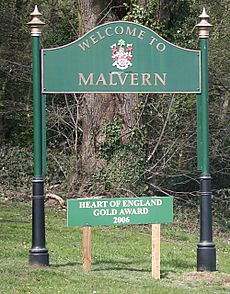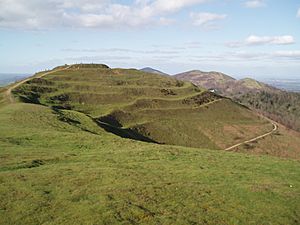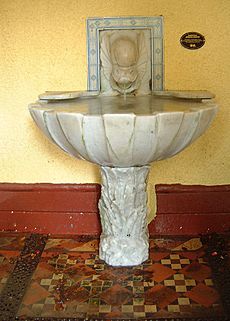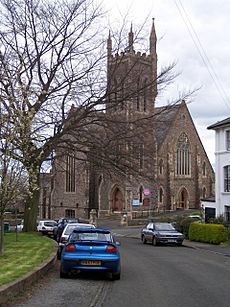Malvern, Worcestershire facts for kids
Quick facts for kids Malvern |
|
|---|---|
 View over the town from Worcestershire Beacon |
|
| Population | 30,462 (2021 Census) |
| OS grid reference | SO786459 |
| • London | 121 miles (195 km) |
| Civil parish |
|
| District |
|
| Shire county | |
| Region | |
| Country | England |
| Sovereign state | United Kingdom |
| Post town | MALVERN |
| Postcode district | WR14 |
| Dialling code | 01684 |
| Police | West Mercia |
| Fire | Hereford and Worcester |
| Ambulance | West Midlands |
| EU Parliament | West Midlands |
| UK Parliament |
|
Malvern (/ˈmɔːlvərn, ˈmɒl-/, locally also: /ˈmɔːvərn/) is a special town in Worcestershire, England. It's known as a "spa town" because of its natural spring water. Malvern sits at the bottom of the beautiful Malvern Hills, which are a protected area called an Area of Outstanding Natural Beauty.
The main part of Malvern, called Great Malvern, is a historic area. It grew very quickly in the Victorian era (the 1800s). This was because people believed the natural spring water, known as Malvern Water, had healing powers.
In 2021, about 30,462 people lived in Malvern. The town includes Great Malvern, which is on the side of the Malvern Hills, and Malvern Link. Many parts of Malvern are separated by open fields and common land. Sometimes, the whole area, including smaller nearby villages, is called "The Malverns."
People lived here as early as the Bronze Age (around 1000 BC). The town itself started in the 11th century when Benedictine monks built a priory (a type of monastery) at the foot of the hills. In the 1800s, Malvern became very popular for its "water cures." Later, it became known for its schools. During World War II, a big science research center moved to Malvern. Today, QinetiQ, a company that grew from that center, is one of the town's biggest employers.
Malvern is the largest town in the West Worcestershire area and the main town of the Malvern Hills district. The town is managed by the Malvern Town Council.
Contents
- What's in a Name?
- Malvern's Story
- How Malvern is Run
- Malvern's Location and Layout
- People of Malvern
- What Malvern Makes and Does
- Malvern's Culture
- Places to Worship
- Getting Around Malvern
- Learning in Malvern
- Fun Things to Do
- Sports
- Famous People from Malvern
- Other Places Named Malvern
- Images for kids
- See also
What's in a Name?
The name Malvern comes from an old British or Welsh word, moel-bryn. This means "Bare or Bald Hill." Over time, the name changed from Malferna (in the 11th century) to Malverne (12th century), and then Much Malvern (16th–17th century).
Malvern's Story
From Ancient Times to Monks
Long ago, in the Bronze Age, people lived in the Malvern area. They left behind tools like flint axes. A very old ditch, called the "Shire Ditch," was built around 1000 BC along the hills. The Wyche Cutting, a path through the hills, was used even in prehistoric times to carry salt.
Some old stories say that a British leader named Caractacus fought his last battle against the Romans at British Camp. This is a place with old earthworks on the Malvern Hills. However, historians are not sure if this story is true.
Archaeologists have found pottery from the Malvern area that dates from the late Bronze Age all the way to the Norman Conquest. This pottery was even traded as far as South Wales!
The Monks of Malvern
Not much is known about Malvern for a thousand years after the Bronze Age. Then, in the 11th century, a Benedictine monastery was built. This is how the town of Malvern began. Today, only the large parish church and the old gateway of the priory remain.
One legend says that a monk named St. Werstan fled from the Danes and found safety in the Malvern woods. He built a small chapel there. Historians believe St. Werstan was indeed an early martyr (someone who died for their beliefs) in the area.

The first leader of the monastery, Aldwyn, started the community around 1085. By 1135, there were thirty monks. An old stained glass window in the Priory church shows the story of St. Werstan. It also shows Edward the Confessor, an English king, giving a special paper (a charter) for the monastery.
Important people like Gilbert de Clare, 7th Earl of Gloucester, who was married to the daughter of King Edward I, owned large lands in Malvern in the late 1200s. Even King Henry VII and his family admired Malvern and gave money to the Priory.
After the Monasteries Closed
During the time when King Henry VIII closed down monasteries in England, Malvern Priory was saved. It was bought by a local person and became a church for the community. Most of the other monastery buildings were taken apart and sold. All that's left of the monastery, besides the church, is the Abbey Gateway. This gateway now holds the Malvern Museum.
Later, in the 1600s, King Charles I tried to sell off parts of the Malvern Chase (a royal hunting ground). But the local people protested and even rioted because they used these lands as common areas. In the end, the public kept their rights to two-thirds of the Malvern Hills lands.
Malvern as a Spa Town

Malvern became famous as a "spa town" because of its special spring water and beautiful scenery. People believed the water had healing powers. As early as the 1600s, a local vicar wrote about the water's benefits. In 1756, a doctor named Dr. John Wall wrote a pamphlet praising Malvern water.
In 1842, two doctors, James Wilson and James Manby Gully, opened clinics in Malvern that focused on "hydrotherapy" (water cures). Malvern quickly grew into a popular place for people to visit for their health. Many large hotels and grand houses were built during this time. By 1865, over a quarter of the town's houses were places for visitors to stay!
Famous people came to Malvern, including Queen Adelaide (in 1842), Charles Darwin, Florence Nightingale, and Lord Tennyson. Even a young Franklin D. Roosevelt, who later became President of the US, visited in 1889.
The railway arrived in Malvern in 1859. This made it much easier for people to visit. Thousands of visitors came on day trips, especially from industrial areas like the Black Country. The railway also helped bring coal, making Malvern a popular winter resort too.
As the 1800s ended, the popularity of water cures declined. Many hotels were turned into private boarding schools. Education then became a very important part of Malvern's economy. The town was a good place for schools because of its nice environment and easy train access.
Malvern in the 20th Century
In the early 1900s, Malvern continued to grow. During World War II, a major change happened. The Telecommunications Research Establishment (TRE), a secret science research center, moved to Malvern in 1942 for safety. This brought many new people to the town. Malvern became a center for scientific research, especially in defense.
How Malvern is Run
Malvern is a town and civil parish. It has its own local government called the Malvern Town Council. This council works within the larger Malvern Hills District of Worcestershire.
Over the years, the boundaries of Malvern have changed. Areas like Great Malvern and Malvern Link, which used to be separate, are now part of the same town. The Malvern Town Council has 15 elected members who represent different areas, or "wards," of the town. These wards include:
- Chase
- Dyson Perrins
- Link
- North Malvern - West Malvern
- Pickersleigh
- Priory
Malvern's Location and Layout
Town Centre
Malvern's town center has two main streets. Many shops, health food stores, art shops, and offices are found here.
Important buildings in the town center include the Malvern Town Council offices and the Malvern Hills Conservators offices. You can also find the Malvern Theatres complex, Priory Park, a swimming pool (Splash leisure complex), the main library, and the tourist information center. In the heart of the town, there's a statue of the famous composer Edward Elgar.
Great Malvern railway station is a beautiful old Victorian building, close to the former Imperial Hotel.
Neighbourhoods
As Malvern grew quickly in the late 1800s, it spread out from Great Malvern. It took in nearby farms and manors, which often gave their names to new neighborhoods. Over time, Malvern grew to include areas like West Malvern, Malvern Wells, and Newland.
Weather
Malvern has a mild climate because it's protected by hills. Summers can be warm, and the warmest day of the year usually reaches about 29.8°C (85.6°F). Winters can be cold, but there are usually only about 33 frosty days a year. The sunniest year on record was 2003. It rains about 740mm (29 inches) per year. Snowfall can vary a lot, depending on the weather patterns.
| Climate data for Malvern, elevation 62m, 1971–2000, Sunshine 1961–90 | |||||||||||||
|---|---|---|---|---|---|---|---|---|---|---|---|---|---|
| Month | Jan | Feb | Mar | Apr | May | Jun | Jul | Aug | Sep | Oct | Nov | Dec | Year |
| Mean daily maximum °C (°F) | 7.3 (45.1) |
7.8 (46.0) |
10.5 (50.9) |
13.2 (55.8) |
17.1 (62.8) |
19.8 (67.6) |
22.4 (72.3) |
21.8 (71.2) |
18.4 (65.1) |
14.2 (57.6) |
10.1 (50.2) |
8.1 (46.6) |
14.3 (57.7) |
| Mean daily minimum °C (°F) | 1.9 (35.4) |
1.8 (35.2) |
3.5 (38.3) |
4.9 (40.8) |
7.6 (45.7) |
10.5 (50.9) |
12.8 (55.0) |
12.5 (54.5) |
10.3 (50.5) |
7.3 (45.1) |
4.2 (39.6) |
2.7 (36.9) |
6.7 (44.1) |
| Average precipitation mm (inches) | 74.95 (2.95) |
55.33 (2.18) |
55.54 (2.19) |
54.51 (2.15) |
52.59 (2.07) |
60.20 (2.37) |
43.26 (1.70) |
60.07 (2.36) |
68.94 (2.71) |
68.74 (2.71) |
65.76 (2.59) |
79.09 (3.11) |
738.99 (29.09) |
| Mean monthly sunshine hours | 50 | 61 | 107 | 139 | 178 | 185 | 191 | 173 | 134 | 91 | 62 | 45 | 1,416 |
| Source: Royal Netherlands Meteorological Institute (RNMI) | |||||||||||||
People of Malvern
In 2011, Malvern had a population of 29,626 people. Most people in Malvern are White British (93.2%).
Malvern's population grew a lot after 1756, when Dr. Wall made the water popular. In the mid-1800s, with the railway's arrival, many health tourists came. By the early 1900s, Malvern had changed from a small village to a town with many large hotels and Victorian houses.
In 1942, the Telecommunications Research Establishment (TRE) moved to Malvern, bringing thousands of employees. This caused the population to grow even more. Many people in Malvern today either work or used to work for this facility, now called QinetiQ.
Malvern also became a place for people from the nearby city of Worcester to live. New motorways in the 1960s made it easier to travel to work. This led to more housing being built.
| Year | Population | Notes |
|---|---|---|
| 1563 | 105 families | Probably what is now the town centre area with nearby farms and manors. |
| 1741 | had sixty houses | Probably what is now the town centre area. |
| 1801 | 819 | |
| 1819 | 2,768 | Probably what is now the town centre area (Great Malvern). |
| 1851 | 3,771 | Probably including the former church areas of Guarlford and Newland, and the settlement of Poolbrook. |
| 1861 | 6,049 | |
| 1881 | 13,216 | |
| 1911 | 16,514 | After Malvern and Malvern Link joined in 1900. |
| 1951 | 21,681 | |
| 1961 | 24,373 | |
| 2001 | 28,749 | Includes the six areas covered by the current Town Council. |
| 2011 | 29,626 | Same area as in 2001. |
| 2021 | 30,462 |
What Malvern Makes and Does
Science and Technology
Since 1942, a big part of Malvern's economy has been research and development in defense and electronics. This started when the Telecommunications Research Establishment (TRE) moved here during World War II. TRE was a very important organization for developing things like radar for the Royal Air Force.
In 2001, this facility became QinetiQ, a private company. It's still a major employer in Malvern. Because of all this science and technology, the Malvern Hills Science Park was built in 1999. It's now home to over 30 science and tech businesses.
Other Industries
Other factories and businesses are mainly located in the Spring Lane Industrial Estate and the Enigma Business Park.
Pipe organs have been built in Malvern by Nicholson Organs since 1841. You can find their organs in famous cathedrals. Cars have also been made in Malvern since 1894 by Santler (Britain's first petrol car) and since 1910 by the Morgan Motor Company. Morgan cars are traditional sports cars, famous around the world.
Farming and Gardening
Malvern is also important for farming. The 70-acre (280,000 m2) Three Counties Showground is just south of Malvern. Since 1958, it has hosted the Royal Three Counties Show every June. This is one of the most important agricultural shows in the UK, attracting thousands of visitors. The showground also hosts the Royal Horticultural Society's Spring Gardening Show and other events throughout the year.
Malvern's Culture
Buildings and Design
Malvern's town center has many beautiful buildings from the Regency, Victorian, and Edwardian periods. Many of these grand houses and hotels were built in the 1800s when Malvern was a popular spa town. When the spa industry declined, many became schools or retirement homes. The Imperial Hotel, built in 1860, was one of the first hotels to be lit by gas.
Many buildings and statues in Malvern celebrate the special Malvern water. For example, St Ann's Well is housed in a building from 1813.
Music Scene
Sir Edward Elgar, a famous British composer, lived much of his life near Malvern. His well-known piece, Pomp and Circumstance, March No. 1, was first played in a school in Malvern. There's a statue of Elgar in the town center. You can also follow the Elgar Route, a 40-mile drive that passes important places from his life.
The Malvern Concert Club, started by Elgar in 1903, holds concerts at the Forum Theatre. The Chandos Symphony Orchestra, with over 100 players, also performs here. In the 1960s, 70s, and 80s, the Malvern Winter Gardens was a popular place for rock concerts, hosting bands like The Rolling Stones and AC/DC.
Plays and Performances
Malvern Theatres, located in the Winter Gardens complex, is a major arts center. The first Malvern Drama Festival was held in 1929 and was dedicated to the playwright George Bernard Shaw. Many of Shaw's plays were first performed here. The theatre has been updated several times, most recently in 2023.
Malvern was also home to The Theatre of Small Convenience, which was in the Guinness World Records as the smallest theatre in the world. It could only hold 12 people! It closed in 2017.
Books and Writers
The famous 14th-century poem The Visions of Piers Plowman was inspired by the Malvern Hills. The poem begins with the line "And on a Maye mornynge on Malverne hylles." The writer, William Langland, might have been educated at the priory in Malvern.
Many other poets wrote about Malvern, including Michael Drayton and William Wordsworth.
C. S. Lewis (who wrote The Lion, the Witch and the Wardrobe) and J. R. R. Tolkien (who wrote The Hobbit and The Lord of the Rings) often visited Malvern. Legend says that one snowy evening, after leaving a Malvern pub, Lewis saw a lamp post shining through the snow. He told his friends it would make a great opening for a book, and this image later appeared in The Lion, the Witch and the Wardrobe. Tolkien also found inspiration in the Malvern landscape. Recordings of Tolkien reading from his books were even made in Malvern in 1952.
The poet W. H. Auden taught at The Downs School in the Malvern Hills in the 1930s. He wrote many poems there, including a long poem simply called The Malverns.
Artworks

Malvern has several sculptures by artist Rose Garrard. These include the statue of Edward Elgar and the Enigma Fountain on Belle Vue Terrace. There's also a drinking fountain called Malvhina on Belle Vue Terrace.
Her "Hand of Peace" war memorial is in the Barnards Green area of Malvern.
Many artists have painted the Malvern Hills and buildings. David Prentice, a founder of Birmingham's Ikon Gallery, has lived in Malvern since 1990 and paints the hills. A sculpture of two buzzards by Walenty Pytel was placed in Rosebank Gardens in 2012 to celebrate the Queen's Diamond Jubilee.
Malvern on TV
The 1962 film Elgar, about the composer, was filmed in Malvern. The Malvern landscape was also used in Penda's Fen, a 1974 TV play. The Tank Quarry on North Hill was a filming location for the Doctor Who episode The Krotons in 1968. Great Malvern railway station appeared in the 1975 TV series Survivors (1975 TV series).
Local News and Radio
You can get local TV news from BBC West Midlands and ITV Central. Local radio stations include BBC Hereford and Worcester and Heart West Midlands. The town's local newspapers are the Malvern Gazette and Malvern Observer.
Malvern Water
Malvern spring water flows freely from many fountains around the town. This water became famous for being very pure. It was the main reason Malvern became a spa town. Even Queen Elizabeth I and Queen Victoria were known to drink it. Until 2010, millions of liters of Malvern water were bottled by Coca-Cola Enterprises. Today, a family business still bottles water from the original source under the name Holywell Spring Water.
Twin Towns
Malvern is twinned with two other spa towns: Mariánské Lázně in the Czech Republic (since 2013) and Bagnères-de-Bigorre in France (since 2016).
Places to Worship
Besides the 12th-century priory, many Christian churches were built in Malvern during the 1800s. Most of these churches look like buildings from the 13th and 14th centuries. One of the newest is St Mary's Church, built in 1958.
Some other churches include:
- All Saints (The Wyche), built in 1903.
- St. Andrew in Poolbrook, built in 1885.
- Christ Church (Avenue Road), built in 1875–76.
- St. Joseph (Newtown Road), built in 1876.
- St. Peter (St. Peter's Road), built in 1863–66.
- Holy Trinity (Worcester Road), built in 1850–51.
Getting Around Malvern
Major roads like the A449 go through Malvern, connecting it to Worcester and Ledbury. The M5 motorway and M50 motorway are also easy to reach from Malvern.
Malvern has two railway stations: Great Malvern and Malvern Link. You can take trains to places like Hereford, Birmingham New Street, and London Paddington.
Local bus services connect different parts of Malvern and nearby villages. Most buses are run by First Midland Red. For air travel, Birmingham Airport is about an hour away. Gloucestershire Airport is closer and used for private flights and pilot training.
Learning in Malvern
Primary Schools
Malvern has thirteen primary schools for younger students. Most of these schools were built between 1836 and 1916, during Malvern's fast growth as a spa town.
High Schools
The Chase School in Barnards Green is a secondary school with about 1300 students. It specializes in Technology, Language, and Science.
Dyson Perrins Church of England Academy in Malvern Link is a Church of England school with almost 1000 students. It specializes in Sports.
Hanley Castle High School is about 4 miles from Malvern, but many students from Malvern go there. It's one of England's oldest schools, founded in 1326.
Private Schools
Malvern has two large private schools: Malvern College (for boys and girls) and Malvern St James (for girls).
Malvern College was founded in 1865. Many famous people have studied there, including Nobel Prize winners and Olympic medalists. It also has a junior school called The Downs Malvern.
Malvern St James was formed in 2006 by combining several girls' schools. Its main building used to be the Imperial Hotel.
Abbey College is an international boarding school mainly for students from other countries.
Further Education
Malvern Hills College offers vocational courses for adults and students over 14. Malvern also has a very active University of the Third Age, which offers many interest groups for older adults.
Fun Things to Do
Priory Park is a large park in the town center. Next to it is the Malvern Splash pool and the Winter Gardens complex. The Winter Gardens is home to the Malvern Theatres, a cinema, concert hall, and cafes. It has been a major place for music and arts for many years. The Splash Leisure Complex has an indoor swimming pool and gym. The town also has a large public library with internet access.
The Worcestershire Way, a 31-mile walking trail, starts in Bewdley and ends in Great Malvern.
Sports
The Manor Park Club has indoor and outdoor sports facilities like tennis, squash, and table tennis. Traditional outdoor bowls is played in Priory Park. Malvern Town FC is the local football team. The Malvern Hills are also a popular place for hang gliding and paragliding. Barnards Green Cricket Club offers a professional cricket ground.
Famous People from Malvern
Many famous people have lived in or visited Malvern. Some came for the water cures, others for the schools, and some worked at the science research facility. The beautiful Malvern Hills have also inspired many writers.
Here are a few notable people:
- Thomas Attwood, an economist, died in Malvern.
- Nigel Coates, an architect, grew up in Malvern.
- Anne Darwin, daughter of Charles Darwin, is buried in Malvern Priory's graveyard.
- Edward Elgar, the famous composer, lived and taught in Great Malvern.
- Franklin D. Roosevelt, who later became US President, stayed in Malvern when he was 7 years old.
- Haile Selassie, the emperor of Ethiopia, visited Malvern during his exile.
- Jacqui Smith, a politician and former Home Secretary, was born and grew up in Malvern.
- J. R. R. Tolkien and C. S. Lewis, famous authors, were inspired by the Malvern Hills.
- W. H. Auden, a poet, wrote many poems while teaching in Malvern.
- Jenny Lind, a famous opera singer, lived and died in Malvern.
- Nigel Kennedy, a violinist, has a home in Malvern.
- Cher Lloyd, a singer, is from Malvern.
- Caroline Lucas, a politician, was born and raised in Malvern.
- David Mitchell, an author, set his novel Black Swan Green in Malvern.
- Jeremy Paxman, a journalist and TV presenter, went to Malvern College.
- Evie Richards, a GB cycling team member, is from Malvern.
Other Places Named Malvern
Malvern has given its name to many other towns and villages around the world. For example, there's a Malverne in New York, USA, and about 15 other places with the name Malvern in countries that were once part of the British Empire.
 |
Bromyard, Tenbury Wells, Leominster, Mid-Wales | Leigh Sinton, Kidderminster, Birmingham | Powick, Callow End, Worcester, Bromsgrove |  |
| Cradley, Mathon, Hereford | Pershore, Evesham, Banbury | |||
| Colwall, Eastnor, Ledbury | Welland, Gloucester | Hanley Swan, Hanley Castle, Upton-upon-Severn, Tewkesbury, Oxford, London |
Images for kids
-
The Abbey Gateway in the town centre is now the home of the Malvern Museum
-
The spa town of Great Malvern was laid out and developed largely during the 19th century
-
The Enigma Fountain and statue of Edward Elgar, a group of sculptures by artist Rose Garrard, on Belle Vue Terrace
See also
 In Spanish: Malvern para niños
In Spanish: Malvern para niños































